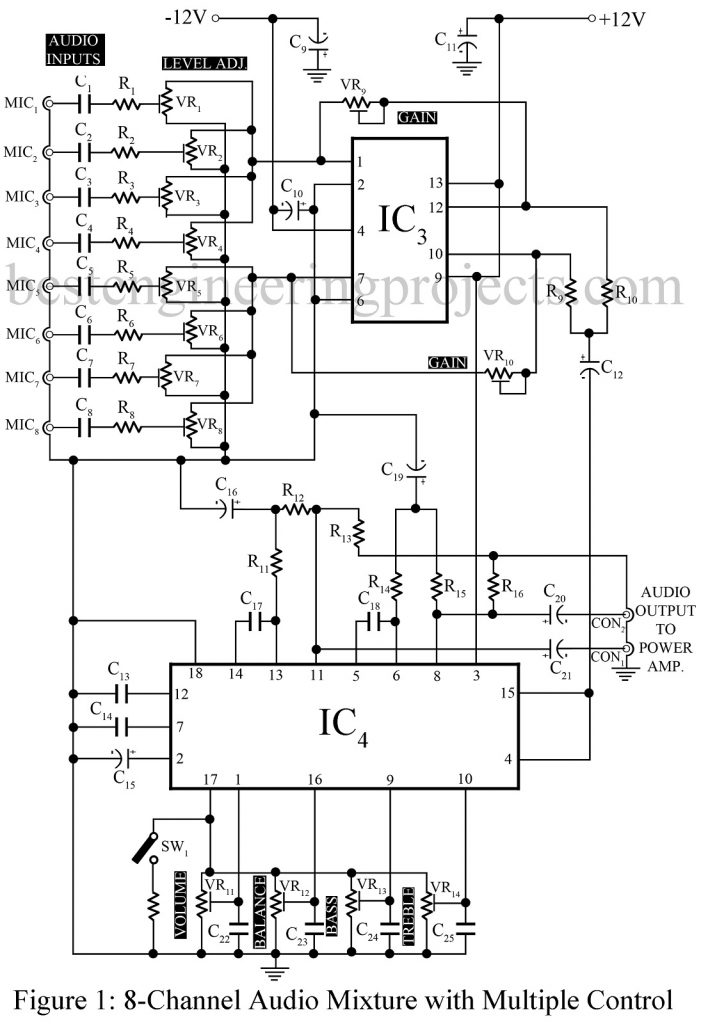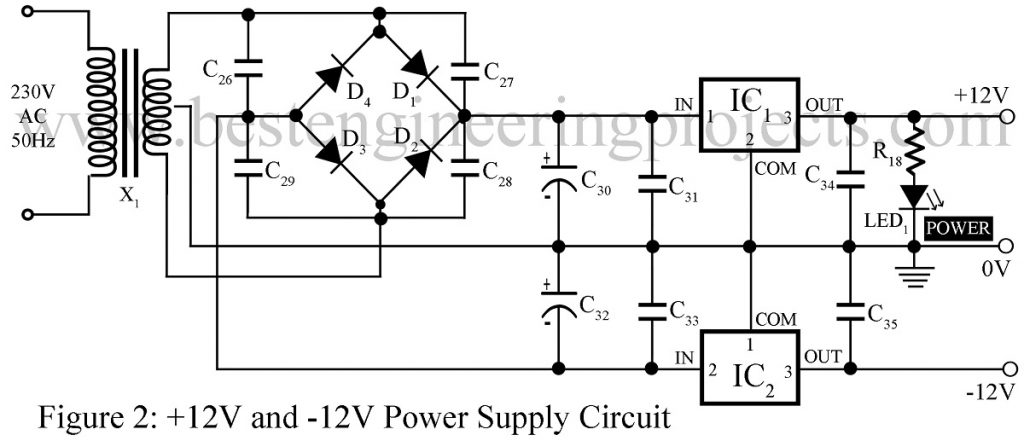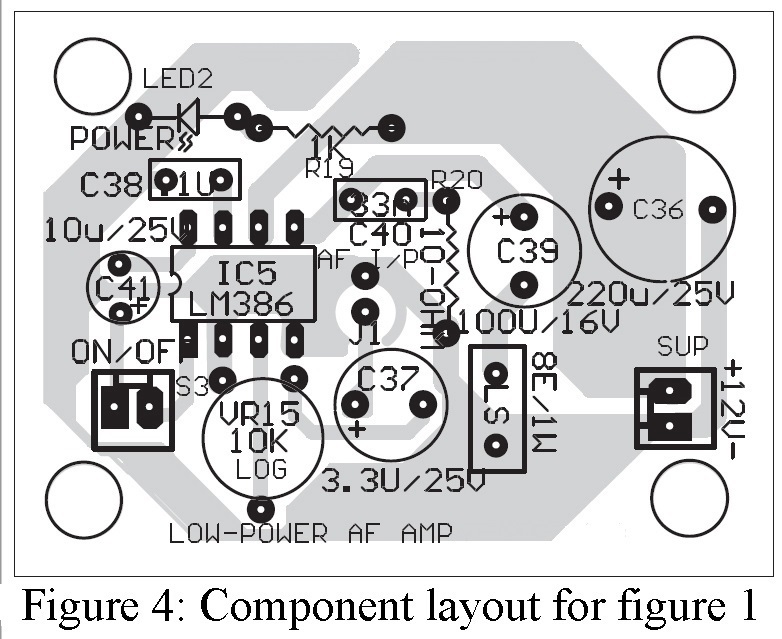Here is simple circuit of eight channel audio mixture with multiple control using IC TDA 1524A and 747 to mix eight individual sound. The PCB for soldering side and component side is also given.
The conventional sound systems involved recording of sounds from several musical instruments, each played by different musicians using only a single microphone. Then, in order to balance the sound tone, they had to alter the positions of musicians according to the microphone. Due to which people started to record directly to stereo master tape. However that method too was troublesome since slight fault in sound tone of any one instrument or voice would destroy the recording completely.
To avoid that they had to check if everything is in place before the recording process starts. So to simplify audio recording process to some extent, we have developed a circuit that takes sound inputs from multiple instruments through eight input levels and then allow the user to balance the sound level from each distinct source till we obtain the desired sound output. The bass, treble, volume and balance controls in the mixer circuit helps us to get that particular sound level we want. For fetching sound inputs from multiple sources, maximum of eight microphones can be employed.
Circuit description Eight Channel Audio Mixture with Multiple Control
To avoid complex circuit diagrams, we decided to break the project into smaller sections which we thought will make it easier for you to go through each phase of the project itself. In figure 1 covers the Eight Channel Audio Mixture together with the tone controller. In the same way figure 2 depicts circuit diagram of the power supply for the project. There are various audio power amplifier is posted in bestengineeringprojects.com like Low Power Audio Power Amplifier which can be used in this circuit.
The system intakes multiple distinct inputs and to mix them thoroughly without any mutual interaction, the dual operational amplifier IC 747 (IC3) is used. In this project, pair of internal amplifier adjust with a common bias network and power supply. Even considering the safety measures, this IC has short-circuited protection features including multiple common-modes and differential voltage ranges.
So as to operate IC3, +12V and –12V regulated DC supplies are incorporated in the circuit. The output signals from each microphone are passed through as M1-M4. And, then the procedure of adjusting sound levels individually, mixing together is followed. These sound levels are fed as inputs to differential input terminals; pin 1 and 2. In the same way, microphone output signals (M5-M8) are fed as inputs to differential terminals; pin 5 and 6 of another inbuilt-amplifier of IC3 after proper adjustment of signals and through mixing.
As we talk about level adjustments for each signal, we have employed logarithmic variable resistors VR1-VR4 and VR5-VR8 for microphone signals M1-M4 and M5-M8 respectively before applying the signals to the amplifiers of IC3. The outputs from amplifiers are pushed through pins 10 and 12. These signals gradually get combined at a point where resistors R9 and R10 are combined. Then signal makes it way to tone controller section through a capacitor C12 (10 µF). Potmeters VR9 and VR10 do the job of maintaining the overall gain of individual amplifiers properly.
IC3 outputs a signal which is then supplied to a junction where input pin 15 and pin 4 of stereo tone controller IC TDA1524A (IC4), are shorted together. You might be wondering why we chose this particular IC (TDA1524A) as a tone controller. Well, there are multiple reasons behind this, the first and foremost reason is because of its design feature. It is constructed to be used as an active stereo-tone/volume control for car radios, TV receivers and mains-fed equipment.
To add more, it also constitutes control systems for bass, treble and volume along with built-in contour control to switch off and balance. DC voltages and a single linear potentiometer can be employed to go back and forth between these functions. And, hence in this project this IC serves it right. However, there can be certain complications while using it with a 9V DC supply, and so for better performance we recommend replacing it with a 12V supply. There is something else that needs equal consideration to improve the performance of the IC and it is a proper heat-sink.
For volume, balance, bass and treble controls, IC comprises potmeters; VR11, VR12, VR13 and VR14 respectively. To alter the tone level of corresponding IC, switch SW2 is included which is named contour switch. Pins 8 and 11 of IC2 are configured as output ports for right and left channel. The IC4 has its input pins 15 and 4(left and right channel) shorted and so it performs as a mono volume/tone control circuit.
Power Supply Circuit for Eight Channel Audio Mixture Multi Control
Figure 2 shows the details of power supply circuit employed in this project. Different components like a step-down transformer (230V AC primary to 12V-0-12V, 1A secondary), bridge rectifier, filter network and regulator ICs comprises this section. Two ICs; 7812 and 7912 are used to generate +12V and –12V regulated DC outputs, respectively which are essential throughout the project. To ensure power availability during project implementation, a switch S1 and LED1 are incorporated. As switch S1 is closed, LED1 glows to indicate the flow of power throughout the circuit.
Construction of Eight Channel Audio Mixture with Multi Control
Once you have gone through the outline and working of the project “Eight Channel Audio Mixture with Multi Control“, it is not difficult to implement in reality. However, some precautions should be strictly followed and if you wish to get the results as stated in the project “Eight Channel Audio Mixture with Multi Control“, you must use component values as prescribed.
Get a closer view at each circuit diagram of Eight Channel Audio Mixture with Multi Control and try to assemble all those components on any general PCB. To avoid IC damage during soldering, use of IC bases on PCB is a common behavior followed in every microcontroller projects so far. It is also because it makes replacing of ICs in the project a lot easier. Audio jack connectors are fixed at the input ports of MIC1 up to MIC8 and at the output port of IC4.
A single-side Solder Side PCB layout for main circuit diagrams (figure 1)in and power supply circuit (figure 2) is given in figure 3 combined together, along with its component layout illustrated in figure 4.
BEP NOTE:- If you want to skip using IC bases for this project, there is a way to do so. The temperature of the solder should be maintained below 260°C and if it reaches this point, it must not be in contact with IC for more than 5 sec. In cases of wave soldering, contact time for successive waves of solder also go beyond five sec.
PARTS LIST OF EIGHT CHANNEL AUDIO MIXTURE WITH MULTIPLE CONTROL
| Resistors (all ¼-watt, ± 5% Carbon) |
| R1 – R8, R18 = 1 KΩ
R9 – R11, R14 = 10 KΩ R12, R15 = 33 KΩ R13, R16 = 4.7 KΩ R17 = 2.2 KΩ R20 = 10 Ω VR1 – VR8, VR15 = 10 KΩ LOG VR9, VR10 = 1 MΩ LIN VR11 – VR14 = 47 KΩ LIN |
| Capacitors |
| C1 – C8, C22 – C25, C31, C33 – C35 = 0.1 µF (Ceramic Disc)
C9 – C12 = 10 µF, 25V (Electrolytic Capacitor) C13, C14 = 15 nF (Ceramic Disc) C15 = 100 µF, 25V (Electrolytic Capacitor) C16, C19 – C21 = 2.2 µF, 25V (Electrolytic Capacitor) C17, C18 = 56 nF (Ceramic Disc) C26 – C29 = 47 nF (Ceramic Disc) C30, C32 = 1000 µF, 25V (Electrolytic Capacitor) |
| Semiconductors |
| IC1 = 7812 (Positive 12V Linear Voltage Regulator)
IC2 = 7912 (Negative 12V Linear Voltage Regulator) IC3 = LM747 (Dual Operational Amplifier) IC4 = TDA1524A (Audio amplifier stereo tone control) D1 – D4 = 1N4001 (Rectifier Diode) LED1 = 5mm LED |
| Miscellaneous |
| X1 = 230V AC Primary to 12V – 0 – 12V, 1A Secondary Transformer
SW1, SW2 = ON/OFF switch |
Check out the other audio mixture circuit posted in bestengineeringprojects.com
Testing procedure of Eight Channel Audio Mixture with Multiple Control
- Once the components are fixed on PCB, keep an eye on the circuit connection fails if any and correct them before passing the power supply to the circuit.
- At input point MIC1 a standard microphone is connected and kept near a audio source.
- Alter the value of potmeter; VR1 to obtain desired output with distinct sound quality and distortion-free amplified output at the end if possible.
- If above solution doesn’t work and altering VR1 is of no help, try adjusting gain control potmeter; VR9.
- And, again if you sense failure, check on volume, balance, bass and treble controls.
- For better results, monitor all the controls set in audio power amplifier section.
- Follow the same procedure for all other input terminals and once you feel all is fine, the audio mixer is ready to be implemented.




i assume U mean Mixer! (not mixture).